Do you have a question about the Panasonic Viera ET5A series and is the answer not in the manual?
Important safety information and warnings for using the TV, including handling, installation, and environmental considerations.
Lists standard and optional accessories, including remote control, batteries, cables, and other peripherals.
Details the functions of the remote control and the TV's main control panel and indicators.
Provides instructions on connecting external equipment and the mains lead to the TV.
Guides users through the automatic process of searching and storing TV channels.
Explains how to access Panasonic's internet services for various online content and applications.
Covers basic TV operation, channel selection, and using TV guides for viewing programs.
Describes how to access and use teletext services for text-based information.
Guides on connecting and viewing content from external devices like VCRs or game consoles.
Provides instructions and precautions for viewing 3D content using 3D eyewear.
Explains how to access special features and functions using the VIERA TOOLS button.
Details how to navigate and utilize the TV's various menu options for settings and configurations.
Instructions on safely handling the power plug and cord to prevent electrical hazards.
Information on the TV's power requirements and safe installation practices.
Warning against tampering with the TV's internal components to avoid electrical shock.
Guidance on ensuring the TV is placed on a stable surface to prevent tipping or falling.
Safety warnings regarding small parts and potential hazards for children.
Critical guidelines for installing the TV securely and safely to prevent accidents.
Instructions on maintaining proper ventilation to prevent overheating and component failure.
Safety information and precautions related to the TV's wireless network capabilities.
List of items included as standard with the TV package.
Details on accessories available for purchase to enhance TV functionality.
Step-by-step guide for replacing batteries in the remote control.
Instructions for safely assembling and disassembling the TV pedestal.
Guidance on securely attaching the TV to its pedestal to prevent falls.
Procedure for safely detaching the pedestal from the television.
Recommendations and methods to secure the TV and prevent it from falling.
Information and warnings regarding the safe installation of the TV when wall-mounted.
Detailed explanation of each button and its function on the remote control.
Description of the TV's physical control buttons and status indicator lights.
Guide on navigating and using the TV's on-screen display menus and operations.
Explanation of the automatic standby feature and its conditions.
Diagram and identification of all available input and output terminals on the TV.
Illustrations showing how to connect the mains lead, aerial, and external equipment.
Diagrams for connecting various AV devices like DVD players, VCRs, and set-top boxes.
Instructions for setting up both wired and wireless network connections for the TV.
Guide on how to use the included clamper for organizing cables.
Step-by-step instructions for performing an automatic channel scan.
Guide for configuring the TV's network settings to enable online services.
Detailed steps for configuring a wired network connection, including IP/DNS settings.
Detailed steps for configuring a wireless network connection, including access point selection.
Guide for setting up wireless connection using WPS push-button method.
Instructions on selecting the appropriate viewing environment for home use.
Initial step to power on the TV before accessing VIERA Connect.
Steps to launch and navigate the VIERA Connect interface.
Methods for selecting channels, including direct entry and using the channel list.
Instructions on how to view and select channels from the organized channel list.
How to display and interpret the information banner shown when changing channels.
How to view and adjust current settings like audio description, video, and audio selection.
Instructions for setting the TV to automatically turn off after a specified period.
Guide on adjusting the picture aspect ratio for optimal viewing.
Details various aspect ratio modes available for different content types.
How to easily switch back to the previously viewed channel or input.
Instructions on how to access and navigate the Electronic Programme Guide (EPG).
Steps to select and watch a program directly from the TV Guide.
Guide on setting timers for recording or reminding programs using USB HDD or SD Card.
Instructions for accessing and using the Freeview electronic program guide.
Explanation of the FASTEXT mode for quick access to teletext information.
How to reveal and hide hidden text, such as quiz answers, in teletext.
Instructions on storing frequently accessed teletext pages for quick retrieval.
How to view TV while waiting for teletext pages to update.
Guide on selecting the correct input source for connected external devices.
How to use the TV remote to control connected media players or other equipment.
Instructions on changing the remote control code to operate different equipment.
Critical warnings regarding the safe use and handling of 3D eyewear.
Guidelines for comfortable and safe viewing of 3D content.
Precautions and recommendations for using 3D eyewear appropriately.
Instructions for properly storing and cleaning the 3D eyewear.
Steps and methods for viewing 3D images from various sources.
Guide on switching between 2D and 3D viewing modes using the 3D button.
How to adjust detailed 3D settings for optimal image display.
Shows the icons representing available features accessible via VIERA TOOLS.
Steps to select and access a specific feature from the VIERA TOOLS menu.
Provides guidance on operating individual features accessed via VIERA TOOLS.
Instructions on how to access and navigate the main menu structure.
Steps for selecting and adjusting specific items within the TV's menus.
Guide on using the on-screen keyboard or numeric buttons for text input.
Adjusts picture settings like Dynamic, Normal, Cinema, True Cinema, and Game modes.
Adjusts levels for backlight, contrast, brightness, color, sharpness, and tint.
Settings to adjust and optimize the display of 3D images.
Controls screen display options, motion picture processing, and film cadence detection.
Adjusts overscan and DVI input settings for optimal picture display.
Selects audio modes like Music, Speech, or User for personalized sound.
Adjusts audio levels for bass, treble, and frequency using the equaliser.
Configures surround sound settings, auto gain control, volume correction, and headphone volume.
Selects preferred digital audio tracks (Dolby D, MPEG, HE-AAC).
Configures digital audio output and HDMI input signal settings.
Settings for narration services for visually impaired users.
Configuration options for network connection, link settings, and software updates.
Options for setting timers for recording or automatic power-off.
Various setup options including Eco Navigation, Recording Setup, and Child Lock.
Includes channel list management, auto/manual tuning, and signal condition checks.
Configures subtitle language, input labels, banner display timeout, and VIERA Connect banner.
Controls VIERA Link functions, HDMI content type, and power saving features.
System-level settings including shipping condition, software updates, and system information.
Options for power saving, region selection, and daylight saving time adjustments.
Guide on creating and managing lists of favorite TV channels.
Instructions on hiding or skipping unwanted channels from the channel list.
Steps to perform an automatic retuning of all receivable channels.
How to check the signal quality and strength for digital TV reception.
Guide on setting timers for programs using the TV menu.
Instructions for specifying channel, date, and time for timer events.
Steps to modify, cancel, or delete existing timer programming events.
How to lock specific channels or inputs and set parental ratings.
Procedure to reset all TV settings to their factory defaults.
Guide on how to update the TV's software automatically or manually.
Steps to select the correct input source for displaying a PC screen.
Details on adjusting PC display settings via the TV's menu.
Fine-tuning picture parameters like white balance and color management.
Guidance on preparing and connecting USB HDDs and SD Cards for recording.
Instructions for formatting and setting up USB HDDs and SD Cards for recording.
Steps for setting up a USB HDD for recording, including naming and confirmation.
Procedure for formatting an SD Card to ensure proper recording and playback.
Guides on recording TV programs using One Touch Recording or REW LIVE TV.
How to record the current program instantly using the remote control.
Instructions for continuously recording the current program using REW LIVE TV.
Information on playing back video files and TV programs recorded on media devices.
Instructions for safely inserting and removing SD Cards and USB flash drives.
Steps to launch the Media Player application.
How to choose the connected storage device (USB HDD, SD Card) for media playback.
Guide on browsing and viewing photos, videos, and music files.
Instructions for viewing photos, including single view and slideshow options.
Detailed steps for viewing individual photos on the screen.
How to organize and sort media files by folder, date, or month.
Guide on creating 3D photos from pairs of images using the TV.
Options for customizing slideshows, including frame type, color effects, and music.
Adjusts how photos are displayed (e.g., Normal, Zoom) during slideshows.
How to select and manage background music for photo slideshows.
Instructions for playing video files, including scene selection and playback operations.
Details on controlling video playback using remote control functions.
Customizes video playback settings like preview, subtitles, aspect ratio, and repeat.
Guide to viewing TV programs recorded on USB HDD or SD Card.
How to group, release, exclude, or change protection status of recorded content.
How to view and play recorded content from a chapter list.
Configures audio output settings for video content, including SPDIF selection.
Instructions for playing music files from storage devices.
Customizes music playback settings like repeat mode and background music.
Information about DLNA Certified products and home network sharing.
Guides on setting up PCs or DIGA Recorders as media servers.
Introduction to VIERA Connect for accessing internet services and online content.
Diagrams illustrating wired and wireless network connection methods.
Steps for configuring network settings, including connection tests.
Enables control of the TV from network equipment via VIERA Link and DLNA.
Detailed configuration for wired network connections, including IP/DNS and proxy settings.
Steps for setting up wireless connections, including access point selection and encryption.
Guide on selecting the Wi-Fi network (SSID) and entering the security key.
Instructions for entering the Wi-Fi password (encryption key) for network access.
Guide on searching for and downloading TV software updates via the internet.
Steps to display and access media servers and select files for playback.
Instructions for playing back photo files from media servers.
Instructions for playing back video files from media servers.
Instructions for playing back music files from media servers.
Customization options for photo, video, and music playback.
Adjusts settings for photo slideshows, including transitions and music.
Customizes video playback settings like preview, subtitles, and aspect ratio.
Customizes music playback settings like repeat mode and background music.
Configures audio output settings for video content, including SPDIF selection.
Details on using VIERA Connect for accessing services like home screen customization and account management.
Overview of connecting equipment via HDMI for VIERA Link functionality.
Table outlining VIERA Link features and their compatibility with different equipment.
Diagrams for connecting equipment via HDMI and audio out terminals.
Information on controlling compatible equipment using VIERA Link.
Details on the HDAVI Control 5 function for enhanced HDMI interoperability.
Steps required before setting up VIERA Link, including connections and equipment setup.
Lists available features like channel download, easy playback, and power links.
How to use Standby Power Save to reduce energy consumption of connected equipment.
Instructions for setting Intelligent Auto Standby to conserve power.
Guide on recording the current program directly to a DIGA Recorder.
How to pause the current TV program and resume later.
Operating the menus of connected equipment using the TV remote.
Steps to select and access the VIERA Link control menu for connected equipment.
Guide on operating the menus of accessed equipment using the TV remote.
How to control TV or home cinema speaker output using the remote.
Instructions for enjoying multi-channel sound via an amplifier.
Diagrams showing recommended connections for HDMI equipment.
Connection guide for DVD players to the TV.
Connection guides for camcorders and game equipment.
How to connect headphones to the TV and adjust volume.
Guide for connecting USB devices like HDDs, cameras, and PCs.
Table showing which equipment can be connected to each TV terminal.
Information on channel allocation and receive channels for analogue TV.
Explanation of rating systems and their meanings for digital TV programs.
List of supported file formats for photos, videos, and music in Media Player.
Details on supported music file formats and restrictions for playback.
Information on DivX Certified video playback, including subtitle support and VOD registration.
Steps to locate and generate the DivX VOD registration code.
Information on SD Cards and USB Flash Memory for recording and playback.
Details on SD Card formats, types, capacities, and usage for recording.
Information on USB HDD and Flash Memory formats and usage for recording/playback.
Guide to connecting the TV via HDMI for high-definition AV interface.
Instructions for connecting a PC to the TV for displaying the screen and sound.
Recommendations and guidelines for connecting USB devices directly to the TV.
Reference table for entering characters using the TV remote's numeric buttons.
Lists compatible input signals for COMPONENT, HDMI, and PC connections.
Troubleshooting steps for issues with picture noise or image artifacts.
Steps to resolve issues where the TV has no image or sound output.
Troubleshooting for issues when the picture appears only in black and white.
Troubleshooting steps when VIERA Link features are not functioning correctly.
Steps to resolve issues with chaotic or noisy picture quality.
Troubleshooting steps when the screen displays no image.
Steps to resolve issues with blurry or distorted images, or low audio volume.
Troubleshooting for any unusual or unexpected image display issues.
Troubleshooting steps when there is no sound output from the TV.
Steps to resolve issues with low volume or distorted sound quality.
Troubleshooting steps for problems related to viewing 3D content.
Troubleshooting steps for issues with establishing a network connection.
Troubleshooting steps when files cannot be selected during DLNA operations.
Troubleshooting steps when DTV channels are missing after tuning.
Steps to resolve issues with intermittent pixelation on TV channels.
Troubleshooting for regular pixelation or 'No Signal' issues on channels.
Troubleshooting steps if the TV fails to power on.
Steps to resolve issues with the remote control's functionality.
Troubleshooting steps for an overcurrent error, often related to USB devices.
General guidance on how to handle and resolve error messages displayed on the TV.
Instructions for cleaning the TV screen, cabinet, and pedestal.
Details on TV broadcast reception standards and frequency bands.
Specifications for AV, HDMI, PC, Ethernet, and USB terminals.
Details on the dimensions, mass, lens type, and materials of the 3D eyewear.
Section for recording product model and serial number for service purposes.
Important safety information and warnings for using the TV, including handling, installation, and environmental considerations.
Lists standard and optional accessories, including remote control, batteries, cables, and other peripherals.
Details the functions of the remote control and the TV's main control panel and indicators.
Provides instructions on connecting external equipment and the mains lead to the TV.
Guides users through the automatic process of searching and storing TV channels.
Explains how to access Panasonic's internet services for various online content and applications.
Covers basic TV operation, channel selection, and using TV guides for viewing programs.
Describes how to access and use teletext services for text-based information.
Guides on connecting and viewing content from external devices like VCRs or game consoles.
Provides instructions and precautions for viewing 3D content using 3D eyewear.
Explains how to access special features and functions using the VIERA TOOLS button.
Details how to navigate and utilize the TV's various menu options for settings and configurations.
Instructions on safely handling the power plug and cord to prevent electrical hazards.
Information on the TV's power requirements and safe installation practices.
Warning against tampering with the TV's internal components to avoid electrical shock.
Guidance on ensuring the TV is placed on a stable surface to prevent tipping or falling.
Safety warnings regarding small parts and potential hazards for children.
Critical guidelines for installing the TV securely and safely to prevent accidents.
Instructions on maintaining proper ventilation to prevent overheating and component failure.
Safety information and precautions related to the TV's wireless network capabilities.
List of items included as standard with the TV package.
Details on accessories available for purchase to enhance TV functionality.
Step-by-step guide for replacing batteries in the remote control.
Instructions for safely assembling and disassembling the TV pedestal.
Guidance on securely attaching the TV to its pedestal to prevent falls.
Procedure for safely detaching the pedestal from the television.
Recommendations and methods to secure the TV and prevent it from falling.
Information and warnings regarding the safe installation of the TV when wall-mounted.
Detailed explanation of each button and its function on the remote control.
Description of the TV's physical control buttons and status indicator lights.
Guide on navigating and using the TV's on-screen display menus and operations.
Explanation of the automatic standby feature and its conditions.
Diagram and identification of all available input and output terminals on the TV.
Illustrations showing how to connect the mains lead, aerial, and external equipment.
Diagrams for connecting various AV devices like DVD players, VCRs, and set-top boxes.
Instructions for setting up both wired and wireless network connections for the TV.
Guide on how to use the included clamper for organizing cables.
Step-by-step instructions for performing an automatic channel scan.
Guide for configuring the TV's network settings to enable online services.
Detailed steps for configuring a wired network connection, including IP/DNS settings.
Detailed steps for configuring a wireless network connection, including access point selection.
Guide for setting up wireless connection using WPS push-button method.
Instructions on selecting the appropriate viewing environment for home use.
Initial step to power on the TV before accessing VIERA Connect.
Steps to launch and navigate the VIERA Connect interface.
Methods for selecting channels, including direct entry and using the channel list.
Instructions on how to view and select channels from the organized channel list.
How to display and interpret the information banner shown when changing channels.
How to view and adjust current settings like audio description, video, and audio selection.
Instructions for setting the TV to automatically turn off after a specified period.
Guide on adjusting the picture aspect ratio for optimal viewing.
Details various aspect ratio modes available for different content types.
How to easily switch back to the previously viewed channel or input.
Instructions on how to access and navigate the Electronic Programme Guide (EPG).
Steps to select and watch a program directly from the TV Guide.
Guide on setting timers for recording or reminding programs using USB HDD or SD Card.
Instructions for accessing and using the Freeview electronic program guide.
Explanation of the FASTEXT mode for quick access to teletext information.
How to reveal and hide hidden text, such as quiz answers, in teletext.
Instructions on storing frequently accessed teletext pages for quick retrieval.
How to view TV while waiting for teletext pages to update.
Guide on selecting the correct input source for connected external devices.
How to use the TV remote to control connected media players or other equipment.
Instructions on changing the remote control code to operate different equipment.
Critical warnings regarding the safe use and handling of 3D eyewear.
Guidelines for comfortable and safe viewing of 3D content.
Precautions and recommendations for using 3D eyewear appropriately.
Instructions for properly storing and cleaning the 3D eyewear.
Steps and methods for viewing 3D images from various sources.
Guide on switching between 2D and 3D viewing modes using the 3D button.
How to adjust detailed 3D settings for optimal image display.
Shows the icons representing available features accessible via VIERA TOOLS.
Steps to select and access a specific feature from the VIERA TOOLS menu.
Provides guidance on operating individual features accessed via VIERA TOOLS.
Instructions on how to access and navigate the main menu structure.
Steps for selecting and adjusting specific items within the TV's menus.
Guide on using the on-screen keyboard or numeric buttons for text input.
Adjusts picture settings like Dynamic, Normal, Cinema, True Cinema, and Game modes.
Adjusts levels for backlight, contrast, brightness, color, sharpness, and tint.
Settings to adjust and optimize the display of 3D images.
Controls screen display options, motion picture processing, and film cadence detection.
Adjusts overscan and DVI input settings for optimal picture display.
Selects audio modes like Music, Speech, or User for personalized sound.
Adjusts audio levels for bass, treble, and frequency using the equaliser.
Configures surround sound settings, auto gain control, volume correction, and headphone volume.
Selects preferred digital audio tracks (Dolby D, MPEG, HE-AAC).
Configures digital audio output and HDMI input signal settings.
Settings for narration services for visually impaired users.
Configuration options for network connection, link settings, and software updates.
Options for setting timers for recording or automatic power-off.
Various setup options including Eco Navigation, Recording Setup, and Child Lock.
Includes channel list management, auto/manual tuning, and signal condition checks.
Configures subtitle language, input labels, banner display timeout, and VIERA Connect banner.
Controls VIERA Link functions, HDMI content type, and power saving features.
System-level settings including shipping condition, software updates, and system information.
Options for power saving, region selection, and daylight saving time adjustments.
Guide on creating and managing lists of favorite TV channels.
Instructions on hiding or skipping unwanted channels from the channel list.
Steps to perform an automatic retuning of all receivable channels.
How to check the signal quality and strength for digital TV reception.
Guide on setting timers for programs using the TV menu.
Instructions for specifying channel, date, and time for timer events.
Steps to modify, cancel, or delete existing timer programming events.
How to lock specific channels or inputs and set parental ratings.
Procedure to reset all TV settings to their factory defaults.
Guide on how to update the TV's software automatically or manually.
Steps to select the correct input source for displaying a PC screen.
Details on adjusting PC display settings via the TV's menu.
Fine-tuning picture parameters like white balance and color management.
Guidance on preparing and connecting USB HDDs and SD Cards for recording.
Instructions for formatting and setting up USB HDDs and SD Cards for recording.
Steps for setting up a USB HDD for recording, including naming and confirmation.
Procedure for formatting an SD Card to ensure proper recording and playback.
Guides on recording TV programs using One Touch Recording or REW LIVE TV.
How to record the current program instantly using the remote control.
Instructions for continuously recording the current program using REW LIVE TV.
Information on playing back video files and TV programs recorded on media devices.
Instructions for safely inserting and removing SD Cards and USB flash drives.
Steps to launch the Media Player application.
How to choose the connected storage device (USB HDD, SD Card) for media playback.
Guide on browsing and viewing photos, videos, and music files.
Instructions for viewing photos, including single view and slideshow options.
Detailed steps for viewing individual photos on the screen.
How to organize and sort media files by folder, date, or month.
Guide on creating 3D photos from pairs of images using the TV.
Options for customizing slideshows, including frame type, color effects, and music.
Adjusts how photos are displayed (e.g., Normal, Zoom) during slideshows.
How to select and manage background music for photo slideshows.
Instructions for playing video files, including scene selection and playback operations.
Details on controlling video playback using remote control functions.
Customizes video playback settings like preview, subtitles, aspect ratio, and repeat.
Guide to viewing TV programs recorded on USB HDD or SD Card.
How to group, release, exclude, or change protection status of recorded content.
How to view and play recorded content from a chapter list.
Configures audio output settings for video content, including SPDIF selection.
Instructions for playing music files from storage devices.
Customizes music playback settings like repeat mode and background music.
Information about DLNA Certified products and home network sharing.
Guides on setting up PCs or DIGA Recorders as media servers.
Introduction to VIERA Connect for accessing internet services and online content.
Diagrams illustrating wired and wireless network connection methods.
Steps for configuring network settings, including connection tests.
Enables control of the TV from network equipment via VIERA Link and DLNA.
Detailed configuration for wired network connections, including IP/DNS and proxy settings.
Steps for setting up wireless connections, including access point selection and encryption.
Guide on selecting the Wi-Fi network (SSID) and entering the security key.
Instructions for entering the Wi-Fi password (encryption key) for network access.
Guide on searching for and downloading TV software updates via the internet.
Steps to display and access media servers and select files for playback.
Instructions for playing back photo files from media servers.
Instructions for playing back video files from media servers.
Instructions for playing back music files from media servers.
Customization options for photo, video, and music playback.
Adjusts settings for photo slideshows, including transitions and music.
Customizes video playback settings like preview, subtitles, and aspect ratio.
Customizes music playback settings like repeat mode and background music.
Configures audio output settings for video content, including SPDIF selection.
Details on using VIERA Connect for accessing services like home screen customization and account management.
Overview of connecting equipment via HDMI for VIERA Link functionality.
Table outlining VIERA Link features and their compatibility with different equipment.
Diagrams for connecting equipment via HDMI and audio out terminals.
Information on controlling compatible equipment using VIERA Link.
Details on the HDAVI Control 5 function for enhanced HDMI interoperability.
Steps required before setting up VIERA Link, including connections and equipment setup.
Lists available features like channel download, easy playback, and power links.
How to use Standby Power Save to reduce energy consumption of connected equipment.
Instructions for setting Intelligent Auto Standby to conserve power.
Guide on recording the current program directly to a DIGA Recorder.
How to pause the current TV program and resume later.
Operating the menus of connected equipment using the TV remote.
Steps to select and access the VIERA Link control menu for connected equipment.
Guide on operating the menus of accessed equipment using the TV remote.
How to control TV or home cinema speaker output using the remote.
Instructions for enjoying multi-channel sound via an amplifier.
Diagrams showing recommended connections for HDMI equipment.
Connection guide for DVD players to the TV.
Connection guides for camcorders and game equipment.
How to connect headphones to the TV and adjust volume.
Guide for connecting USB devices like HDDs, cameras, and PCs.
Table showing which equipment can be connected to each TV terminal.
Information on channel allocation and receive channels for analogue TV.
Explanation of rating systems and their meanings for digital TV programs.
List of supported file formats for photos, videos, and music in Media Player.
Details on supported music file formats and restrictions for playback.
Information on DivX Certified video playback, including subtitle support and VOD registration.
Steps to locate and generate the DivX VOD registration code.
Information on SD Cards and USB Flash Memory for recording and playback.
Details on SD Card formats, types, capacities, and usage for recording.
Information on USB HDD and Flash Memory formats and usage for recording/playback.
Guide to connecting the TV via HDMI for high-definition AV interface.
Instructions for connecting a PC to the TV for displaying the screen and sound.
Recommendations and guidelines for connecting USB devices directly to the TV.
Reference table for entering characters using the TV remote's numeric buttons.
Lists compatible input signals for COMPONENT, HDMI, and PC connections.
Troubleshooting steps for issues with picture noise or image artifacts.
Steps to resolve issues where the TV has no image or sound output.
Troubleshooting for issues when the picture appears only in black and white.
Troubleshooting steps when VIERA Link features are not functioning correctly.
Steps to resolve issues with chaotic or noisy picture quality.
Troubleshooting steps when the screen displays no image.
Steps to resolve issues with blurry or distorted images, or low audio volume.
Troubleshooting for any unusual or unexpected image display issues.
Troubleshooting steps when there is no sound output from the TV.
Steps to resolve issues with low volume or distorted sound quality.
Troubleshooting steps for problems related to viewing 3D content.
Troubleshooting steps for issues with establishing a network connection.
Troubleshooting steps when files cannot be selected during DLNA operations.
Troubleshooting steps when DTV channels are missing after tuning.
Steps to resolve issues with intermittent pixelation on TV channels.
Troubleshooting for regular pixelation or 'No Signal' issues on channels.
Troubleshooting steps if the TV fails to power on.
Steps to resolve issues with the remote control's functionality.
Troubleshooting steps for an overcurrent error, often related to USB devices.
General guidance on how to handle and resolve error messages displayed on the TV.
Instructions for cleaning the TV screen, cabinet, and pedestal.
Details on TV broadcast reception standards and frequency bands.
Specifications for AV, HDMI, PC, Ethernet, and USB terminals.
Details on the dimensions, mass, lens type, and materials of the 3D eyewear.
Section for recording product model and serial number for service purposes.
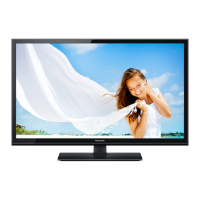
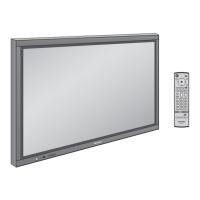
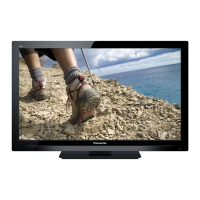
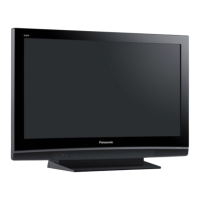

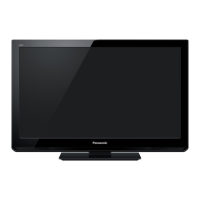
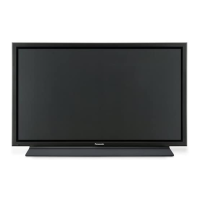
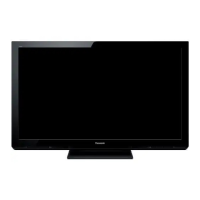

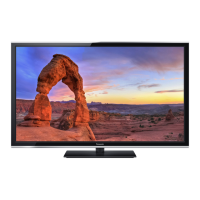
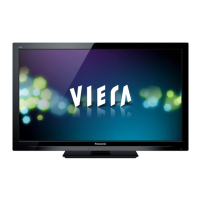

